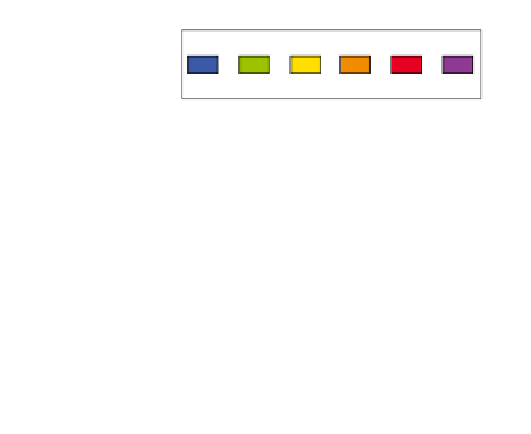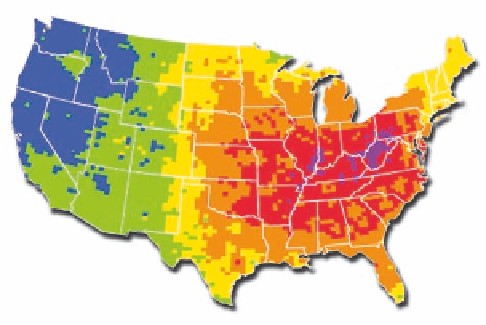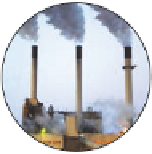Environmental Engineering Reference
In-Depth Information
standard,
is intended to prevent environmental and
property damage. Each standard specifies the maxi-
mum allowable level, averaged over a specific period,
for a certain pollutant in outdoor (ambient) air. The
EPA has also established national emission standards
for more than 188
hazardous air pollutants
(
HAPs
) that
may cause serious
health
and
ecological effects.
These
chemicals include neurotoxins, carcinogens, muta-
gens, teratogens, endocrine system disrupters, and
other toxic compounds. Most of these chemicals are
chlorinated hydrocarbons, VOCs, or compounds of
toxic metals.
One of the best sources of information about HAPs
in a local area is the annual
Toxic Release Inventory
(
TRI),
which is collected and released to the public as
part of community “right to know” laws enacted by
Congress in 1986. The TRI law requires 23,000 refiner-
ies, power plants, hardrock mines, chemical manufac-
turers, and factories to report their releases above cer-
tain minimum amounts and their waste management
methods for 667 toxic chemicals.
Great news.
According to a 2003 EPA report, aggre-
gate emissions of the six criteria air pollutants de-
creased by 48% between 1970 and 2002 even with
significant increases in gross domestic product, vehicle
miles traveled, energy consumption, and population.
Bad news.
After dropping in the 1980s, smog levels
did not decline between 1993 and 2002 mostly because
reducing smog requires much bigger cuts in emissions
of nitrogen oxides from power and industrial plants
and motor vehicles. Also, according to the EPA, in 2003
more than 170 million people lived in 470 of the na-
tion's 2,700 counties in 31 states where air is unhealthy
to breathe during part of the year because of high levels
of air pollutants—primarily ozone and fine particles. In
2004, the EPA estimated that airborne fine particles
cause 15,000 premature deaths and 95,000 cases of
chronic or acute bronchitis per year. And according to a
2004 joint study by the Environmental Integrity Project
and the Galveston Houston Association for Smog Pre-
vention, refinery and chemical plant emissions of ma-
jor toxic pollutants may actually be four to five times
higher than is currently being reported by the EPA and
nearly all state governments.
Deaths per 100,000 adults
<1
1-5
5-10 10-20 20-30
30+
Figure 15-16
Premature deaths from air pollution in the United
States, mostly from coal-burning power plants.
Critical thinking:
what is the risk where you live?
(Data from U.S. Environmental
Protection Agency)
in indoor air and in outdoor air from coal-burning
power plants, mostly in the eastern half of the United
States (Figure 15-16).
According to recent studies by the EPA, each year
more than 125,000 Americans (120,000 of them in
urban areas) get cancer from breathing soot-laden
diesel fumes from buses and trucks. Other sources of
these fumes include tractors, bulldozers and other con-
struction equipment, portable generators, and other
off-road diesel vehicles. In one year, a large diesel-
powered bulldozer can produce as much air pollution
as 26 cars.
15-7 PREVENTING AND REDUCING
AIR POLLUTION
Politics: Air Pollution Laws
in the United States
The Clean Air Acts in the United States have greatly
reduced outdoor air pollution from six major
pollutants.
The U.S. Congress passed the Clean Air Acts in 1970,
1977, and 1990. With these laws, the federal govern-
ment established key air pollution regulations that are
enforced by each state and by major cities.
Congress directed the EPA to establish
national am-
bient air quality standards (NAAQS)
for six outdoor cri-
teria pollutants (Table 15-1). The EPA regulates these
chemicals by using
criteria
developed from risk assess-
ment methods to set maximum permissible levels in
outdoor air.
One limit, called a
primary standard,
is set to pro-
tect human health. Another limit, called a
secondary
Politics: Improving U.S. Air
Pollution Laws
Environmental scientists applaud the success of U.S.
air pollution control laws but have suggested several
ways to make them more effective.
The reduction of outdoor air pollution in the United
States since 1970 has been a remarkable success story.
It occurred because of two factors.
First,
U.S. citizens
insisted that laws be passed and enforced to improve
air quality.
Second,
the country was affluent enough to
afford such controls and improvements.





